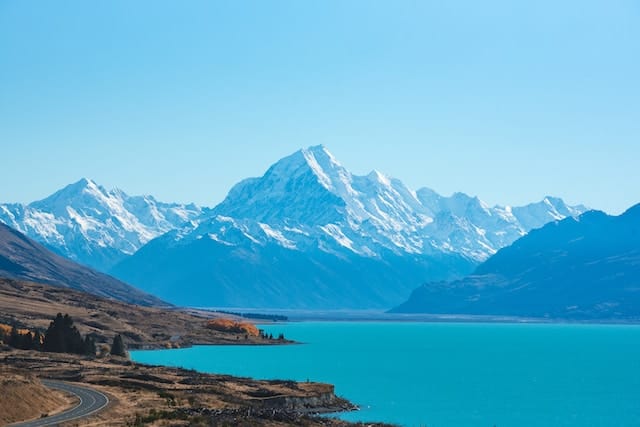New Zealand, a picturesque island nation in the southwestern Pacific Ocean, is widely known for its stunning landscapes, friendly locals, and high quality of life. With a diverse array of urban centers and rural havens, it’s no wonder that choosing the perfect place to call home can be a challenging decision. In this comprehensive guide, we delve into the best places to live in New Zealand, taking into account factors such as employment opportunities, education facilities, lifestyle, attractions, and cost of living.
1. Auckland
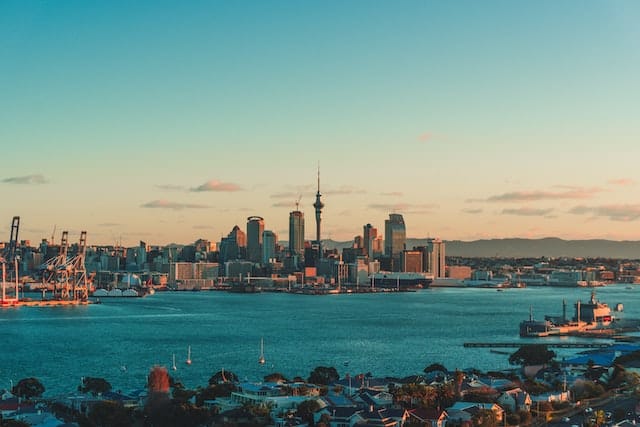
As New Zealand’s largest and most populous city, Auckland is a vibrant urban hub that offers a plethora of opportunities for both work and leisure. Home to over 1.7 million residents, the “City of Sails” boasts a thriving economy, with sectors such as technology, finance, and tourism driving its growth.
Employment Opportunities: Auckland’s strong job market attracts professionals from various industries. Key sectors include information and communications technology (ICT), financial services, and creative industries. Additionally, the city serves as a base for many multinational companies, providing ample job opportunities for expatriates and locals alike.
Education Facilities: Auckland is a hub for education, with numerous top-tier institutions, including the University of Auckland, Auckland University of Technology, and Unitec Institute of Technology. These institutions offer a wide range of courses catering to students with diverse interests and career goals.
Lifestyle and Attractions: Auckland’s unique blend of urban and natural landscapes provides a dynamic lifestyle for residents. The city is surrounded by beautiful beaches, lush forests, and volcanic hills, offering countless outdoor activities. In contrast, the bustling city center offers world-class dining, shopping, and cultural attractions, such as the Auckland Art Gallery and the Sky Tower.
Cost of Living: While Auckland offers a high quality of life, it comes with a relatively high cost of living. Housing prices and rental rates tend to be higher than in other parts of New Zealand. However, the higher salaries and numerous amenities often offset these costs for many residents.
2. Wellington
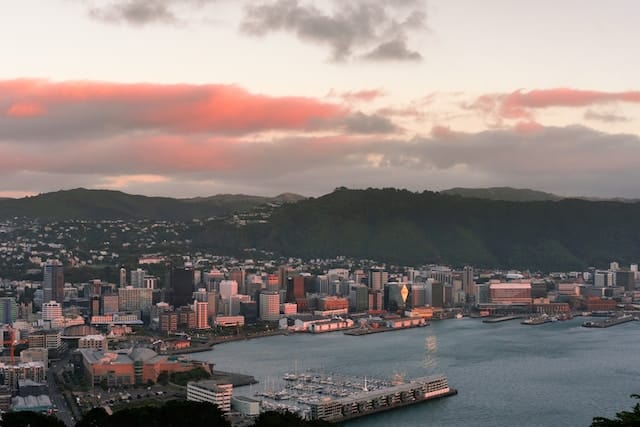
As the capital city of New Zealand, Wellington is a charming, compact metropolis with a thriving arts and culture scene. With a population of around 215,000, it offers a more intimate urban experience than Auckland.
Employment Opportunities: Wellington’s economy is primarily driven by the public sector, with many government agencies headquartered in the city. Other significant industries include film and television production, ICT, and tourism. Wellington is home to Weta Workshop, a renowned visual effects company that has contributed to several blockbuster films.
Education Facilities: Wellington is well-served by reputable educational institutions, including Victoria University of Wellington, Massey University, and the Wellington Institute of Technology. These establishments cater to a diverse array of academic and vocational fields, ensuring that students have access to quality education.
Lifestyle and Attractions: Wellington is renowned for its vibrant arts scene, with numerous galleries, theatres, and live music venues. The city’s picturesque waterfront, thriving café culture, and close proximity to nature make it an attractive option for those seeking a balanced lifestyle. Popular attractions include Te Papa Tongarewa (the Museum of New Zealand), Zealandia Ecosanctuary, and the iconic Wellington Cable Car.
Cost of Living: Wellington has a more moderate cost of living compared to Auckland, but still ranks as one of the more expensive cities in New Zealand. Housing and rental prices are relatively high, but public transport and other daily expenses tend to be more affordable..
3. Christchurch
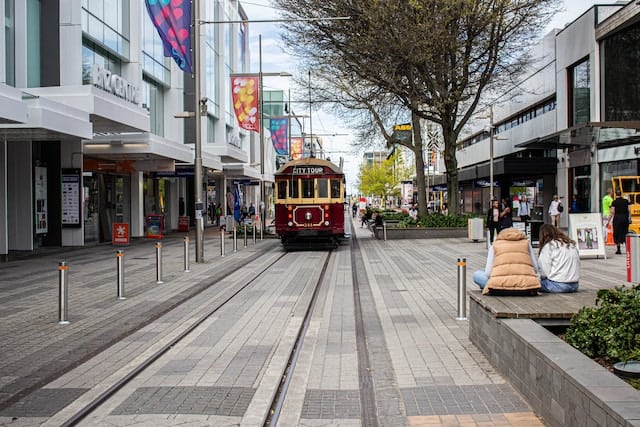
Christchurch, known as the “Garden City,” is the largest city on New Zealand’s South Island. With a population of approximately 385,000, it has become a symbol of resilience following the devastating earthquakes of 2010 and 2011. The city has since undergone extensive reconstruction, transforming into a modern and vibrant urban center.
Employment Opportunities: Christchurch’s economy is diverse, with key industries including agriculture, manufacturing, construction, and technology. The city has also become a center for innovation, attracting startups and entrepreneurs. Major employers include the Christchurch City Council, the University of Canterbury, and several multinational corporations.
Education Facilities: Christchurch offers a range of high-quality educational institutions, such as the University of Canterbury, Lincoln University, and the Ara Institute of Canterbury. These institutions provide various academic and vocational programs, ensuring students can pursue their desired fields of study.
Lifestyle and Attractions: Christchurch is a haven for outdoor enthusiasts, with the city’s numerous parks, gardens, and easy access to the surrounding natural beauty of the South Island. Residents can enjoy activities such as hiking, mountain biking, and skiing in the nearby Southern Alps. The city also boasts a thriving arts and culture scene, with venues like the Christchurch Art Gallery and the Isaac Theatre Royal hosting various events and performances.
Cost of Living: The cost of living in Christchurch is generally more affordable than in Auckland or Wellington. Housing prices and rental rates are comparatively lower, allowing residents to enjoy a comfortable lifestyle without breaking the bank.
4. Queenstown
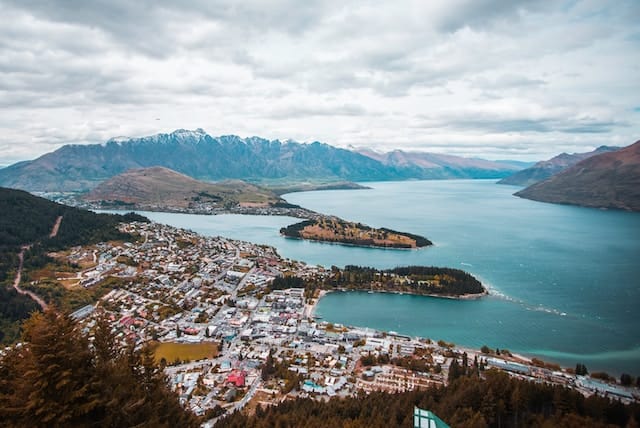
Nestled along the shores of Lake Wakatipu and surrounded by the dramatic Southern Alps, Queenstown is a picturesque resort town that has become synonymous with adventure tourism. With a population of around 16,000, it offers a small-town atmosphere while providing world-class amenities and attractions.
Employment Opportunities: Queenstown’s economy is predominantly driven by tourism, with a significant number of jobs in the hospitality, retail, and adventure tourism sectors. Additionally, the town’s growth and development have created opportunities in construction, real estate, and other service industries.
Education Facilities: While Queenstown does not have large universities, it does offer tertiary education through the Queenstown Resort College, which specializes in hospitality, tourism, and adventure tourism management. The town also has reputable primary and secondary schools for families with children.
Lifestyle and Attractions: Queenstown is an outdoor lover’s paradise, offering a range of adventure activities such as bungee jumping, jet boating, and skiing. The town’s stunning natural environment also provides opportunities for more leisurely pursuits like hiking, fishing, and wine tasting at nearby vineyards. The lively town center features a variety of restaurants, bars, and shops catering to both residents and tourists.
Cost of Living: Queenstown’s popularity as a tourist destination has led to a relatively high cost of living, particularly when it comes to housing and rental prices. However, many residents find the unparalleled lifestyle and beautiful surroundings worth the premium.
5. Dunedin
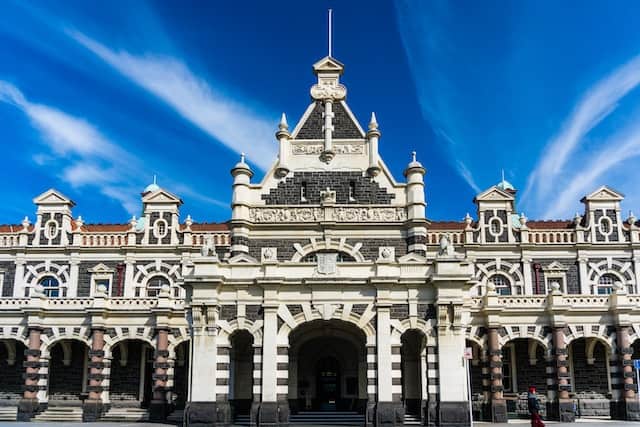
Dunedin, located on the southeastern coast of New Zealand’s South Island, is a charming city with a rich cultural heritage and strong Scottish influences. With a population of around 130,000, it offers a unique blend of urban amenities and stunning natural surroundings.
Employment Opportunities: Dunedin’s economy is diverse, with key industries such as education, healthcare, manufacturing, and technology. Major employers include the University of Otago, the Southern District Health Board, and various multinational companies.
Education Facilities: Dunedin is home to the prestigious University of Otago, New Zealand’s oldest university, and the Otago Polytechnic. These institutions offer a wide range of academic and vocational programs, attracting students from across the country and around the world.
Lifestyle and Attractions: Dunedin’s unique heritage and vibrant arts scene make it an attractive destination for those who appreciate culture and history. The city boasts numerous museums, galleries, and theatres, as well as beautiful Victorian and Edwardian architecture. Its picturesque location on the Otago Peninsula provides ample opportunities for outdoor pursuits, such as wildlife spotting, hiking, and surfing at nearby beaches.
Cost of Living: The cost of living in Dunedin is relatively affordable compared to other major cities in New Zealand. Housing prices and rental rates are generally lower, making it an attractive option for those seeking a more budget-friendly lifestyle without sacrificing quality of life.
6. Tauranga
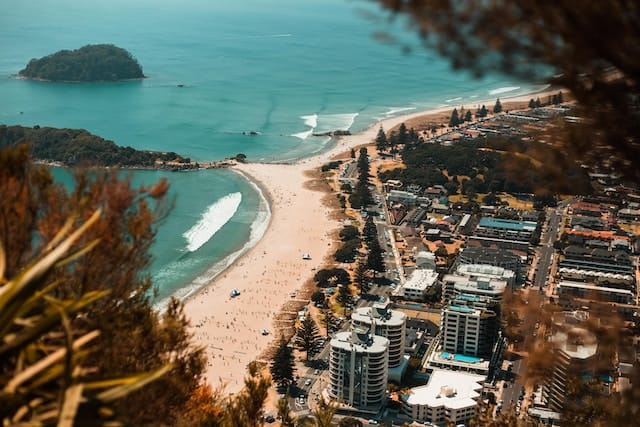
Tauranga, situated in the beautiful Bay of Plenty region on New Zealand’s North Island, is a fast-growing coastal city with a population of around 140,000. Its stunning natural surroundings, sunny climate, and thriving economy make it an appealing choice for people of all ages and backgrounds.
Employment Opportunities: Tauranga’s economy is driven by sectors such as horticulture, logistics, manufacturing, and tourism. The Port of Tauranga, New Zealand’s largest port, also provides numerous job opportunities. The city’s strong economic growth has attracted a diverse range of businesses and industries.
Education Facilities: Tauranga offers several quality educational institutions, including the University of Waikato’s Tauranga campus and the Toi Ohomai Institute of Technology. These schools provide a variety of academic and vocational programs, ensuring students have access to quality education.
Lifestyle and Attractions: Tauranga’s beautiful beaches, vibrant waterfront, and warm climate make it an ideal destination for those seeking an active, outdoor lifestyle. The city also offers a range of cultural and entertainment options, including galleries, museums, and a growing culinary scene. Popular attractions include Mount Maunganui, McLaren Falls Park, and the Tauranga Art Gallery.
Cost of Living: The cost of living in Tauranga is generally more affordable than in Auckland or Wellington, though it has been steadily increasing due to the city’s rapid growth. Housing prices and rental rates are relatively moderate, making Tauranga an attractive option for those seeking a balance between affordability and quality of life.
7. Hamilton

Located in the heart of the Waikato region on New Zealand’s North Island, Hamilton is a thriving city with a population of around 170,000. Its central location, strong economy, and rich cultural heritage make it an appealing choice for families, students, and professionals alike.
Employment Opportunities: Hamilton’s diverse economy is driven by sectors such as agriculture, education, healthcare, and technology. The city is home to numerous research institutes and innovation hubs, attracting businesses and talent from various industries.
Education Facilities: Hamilton is well-served by educational institutions, including the University of Waikato and the Waikato Institute of Technology (Wintec). These schools offer a wide range of academic and vocational programs, ensuring students have access to quality education.
Lifestyle and Attractions: Hamilton’s rich cultural heritage is evident in its numerous museums, galleries, and performance venues, such as the Waikato Museum and the Claudelands Event Centre. The city also offers a variety of outdoor activities, thanks to its proximity to the Waikato River and the lush Hamilton Gardens. Popular attractions include the Hamilton Zoo, the Waitomo Glowworm Caves, and the Hobbiton Movie Set.
Cost of Living: Hamilton offers a more affordable cost of living compared to some of New Zealand’s larger cities, with housing prices and rental rates being relatively moderate. This affordability, combined with the city’s strong economy and amenities, makes Hamilton an attractive option for those seeking a balanced lifestyle.
8. Nelson
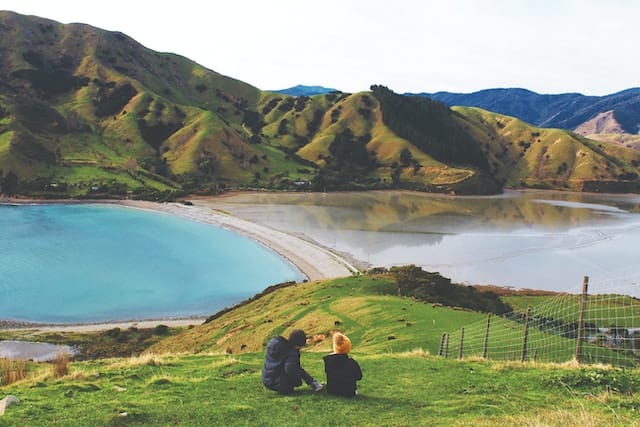
Nelson, located at the top of New Zealand’s South Island, is a picturesque coastal city known for its sunny climate, vibrant arts scene, and outdoor recreational opportunities. With a population of around 50,000, it offers a relaxed, small-town atmosphere while providing a range of amenities and attractions for its residents.
Employment Opportunities: Nelson’s economy is diverse, with key industries such as horticulture, forestry, seafood, and tourism. The city’s thriving arts and crafts scene also provides opportunities for artists, artisans, and small business owners.
Education Facilities: Nelson is home to the Nelson Marlborough Institute of Technology (NMIT), which offers a range of academic and vocational programs in various fields, including aviation, viticulture, and marine engineering. The city also has several reputable primary and secondary schools for families with children.
Lifestyle and Attractions: Nelson’s residents enjoy a high quality of life, thanks to its sunny climate, beautiful beaches, and abundant recreational opportunities. The city is surrounded by three national parks – Abel Tasman, Kahurangi, and Nelson Lakes – providing ample opportunities for hiking, kayaking, and mountain biking. Nelson is also renowned for its lively arts scene, hosting numerous festivals and events, including the Nelson Arts Festival and the World of WearableArt Awards Show.
Cost of Living: The cost of living in Nelson is generally more affordable than in some of New Zealand’s larger cities, with housing prices and rental rates being relatively moderate. This affordability, combined with the city’s strong economy and vibrant lifestyle, makes Nelson an attractive option for those seeking a balanced and fulfilling life.
9. Napier

Napier, situated on the eastern coast of New Zealand’s North Island, is a charming city known for its stunning Art Deco architecture, vibrant arts scene, and picturesque location within the Hawke’s Bay region. With a population of around 65,000, it offers a relaxed and welcoming atmosphere while providing a range of amenities and attractions for its residents.
Employment Opportunities: Napier’s economy is primarily driven by sectors such as agriculture, horticulture, manufacturing, and tourism. The city’s location in the renowned Hawke’s Bay wine region also provides job opportunities in viticulture and wine production.
Education Facilities: Napier is home to the Eastern Institute of Technology (EIT), which offers a range of academic and vocational programs in various fields, including business, health sciences, and hospitality. The city also has several reputable primary and secondary schools for families with children.
Lifestyle and Attractions: Residents of Napier enjoy a high quality of life, thanks to its sunny climate, beautiful beaches, and abundant recreational opportunities. The city’s unique Art Deco architecture and vibrant arts scene make it a cultural hub, with numerous galleries, museums, and events such as the annual Art Deco Festival. Napier’s location in the Hawke’s Bay region also offers easy access to wineries, orchards, and stunning natural landscapes for outdoor enthusiasts.
Cost of Living: The cost of living in Napier is generally more affordable than in some of New Zealand’s larger cities, with housing prices and rental rates being relatively moderate. This affordability, combined with the city’s strong economy and diverse lifestyle offerings, makes Napier an attractive option for those seeking a balanced and enjoyable life.
10. New Plymouth
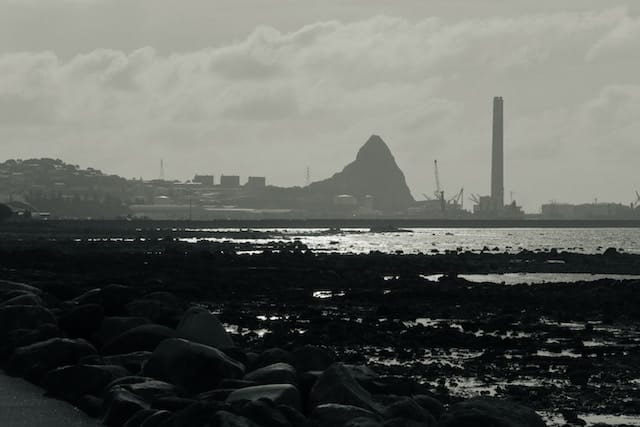
New Plymouth, situated on the west coast of New Zealand’s North Island, is a vibrant coastal city known for its stunning natural landscapes, rich cultural heritage, and thriving arts scene. With a population of around 60,000, it offers a relaxed, friendly atmosphere while providing a range of amenities and attractions for its residents.
Employment Opportunities: New Plymouth’s economy is primarily driven by sectors such as energy, agriculture, engineering, and tourism. The city is home to the country’s largest onshore natural gas field and several major energy companies, creating numerous job opportunities in the energy sector.
Education Facilities: New Plymouth is home to the Western Institute of Technology at Taranaki (WITT), which offers a range of academic and vocational programs in various fields, including business, health sciences, and creative industries. The city also has several reputable primary and secondary schools for families with children.
Lifestyle and Attractions: Residents of New Plymouth enjoy a high quality of life, thanks to its mild climate, beautiful beaches, and abundant recreational opportunities. The city is surrounded by stunning natural landscapes, including Mount Taranaki, Egmont National Park, and the coastal walkway, providing ample opportunities for hiking, surfing, and outdoor activities. New Plymouth also boasts a thriving arts scene, with numerous galleries, museums, and events such as the annual Taranaki Arts Festival.
Cost of Living: The cost of living in New Plymouth is generally more affordable than in some of New Zealand’s larger cities, with housing prices and rental rates being relatively moderate. This affordability, combined with the city’s strong economy and diverse lifestyle offerings, makes New Plymouth an attractive option for those seeking a balanced and enjoyable life.
| Rank | City | Criteria |
|---|---|---|
| 1 | Auckland | Largest city, strong job market, excellent education facilities, urban lifestyle |
| 2 | Wellington | Capital city, vibrant arts scene, public sector and creative industries jobs |
| 3 | Christchurch | Garden City, diverse job opportunities, access to South Island’s natural beauty |
| 4 | Queenstown | Resort town, adventure tourism, unique lifestyle, tourism-driven economy |
| 5 | Dunedin | Historic city, rich cultural heritage, diverse job opportunities, affordable cost of living |
| 6 | Tauranga | Fast-growing coastal city, warm climate, strong economy, outdoor activities |
| 7 | Hamilton | Centrally located, diverse economy, rich cultural heritage, affordable cost of living |
| 8 | Nelson | Coastal city, sunny climate, vibrant arts scene, outdoor recreational opportunities |
| 9 | Napier | Art Deco architecture, vibrant arts scene, Hawke’s Bay region, diverse economy |
| 10 | New Plymouth | West coast location, natural landscapes, rich cultural heritage, thriving arts scene |
Conclusion
New Zealand offers a diverse range of cities and towns, each with its own uniqu characteristics, advantages, and attractions. From bustling urban centers like Auckland and Wellington to picturesque resort towns like Queenstown and coastal gems like Tauranga, there is a perfect place for everyone, depending on their lifestyle preferences, career goals, and financial considerations.
When choosing the best place to live in New Zealand, it’s essential to carefully weigh the factors that are most important as job opportunities, education facilities, lifestyle, attractions, and cost of living. By considering these aspects and taking into account the unique offerings of each city or town, you can make an informed decision about where to call home in this beautiful island nation.
It’s also crucial to remember that New Zealand is a country that values community, diversity, and a strong work-life balance. No matter where you choose to live, you’re likely to find friendly locals, a high quality of life, and ample opportunities to connect with nature and explore the stunning landscapes for which the country is renowned.
To further assist you in your decision-making process, it may be helpful to visit potential locations, research local job markets and housing costs, and speak with residents to gain firsthand insights into the lifestyle and opportunities available in each area.
In summary, the best cities to live in New Zealand are as follows:
- Auckland – New Zealand’s largest city, providing a dynamic urban lifestyle with a robust job market and top-notch education facilities.
- Wellington – The captivating capital city, celebrated for its vibrant arts scene and abundant employment opportunities in both the public sector and creative industries.
- Christchurch – The resilient “Garden City,” boasting diverse job prospects and convenient access to the breathtaking natural beauty of the South Island.
- Queenstown – A scenic resort town renowned for adventure tourism, offering a distinctive lifestyle and a flourishing tourism-driven economy.
- Dunedin – A historically rich city with pronounced Scottish influences, delivering a diverse cultural heritage, varied job opportunities, and a comparatively affordable cost of living.
- Tauranga – A rapidly growing coastal city in the stunning Bay of Plenty region, presenting a warm climate, robust economy, and an array of outdoor activities.
- Hamilton – A strategically located city in the Waikato region, characterized by a diverse economy, rich cultural heritage, and a more budget-friendly cost of living.
- Nelson – A picturesque coastal city in the South Island, known for its sunny climate, lively arts scene, and numerous outdoor recreational opportunities.
- Napier – A charming city on the eastern coast of the North Island, famous for its stunning Art Deco architecture, vibrant arts scene, and location within the renowned Hawke’s Bay region.
- New Plymouth – A vibrant coastal city on the North Island’s west coast, celebrated for its impressive natural landscapes, rich cultural heritage, and thriving arts scene.
Ultimately, the decision of where to live in New Zealand will be a personal one, based on your unique preferences, priorities, and circumstances. By researching each location and considering the factors most important to you, you can find the ideal home in one of the world’s most breathtaking and welcoming countries.
Frequently Asked Questions
Where not to live in New Zealand?
It’s difficult to advise where not to live in New Zealand since preferences for locations can vary greatly depending on individual tastes, lifestyle choices, and priorities. What may be unsuitable for one person might be perfect for another. However, when choosing where to live, consider factors such as job opportunities, natural hazards, climate, crime rates, and the cost of living. Some areas may have higher crime rates or be more prone to earthquakes or flooding, making them less desirable for certain individuals. It is essential to research and visit potential locations to make an informed decision based on your specific needs and preferences.
What is the best city to live in New Zealand?
The best city to live in New Zealand is Auckland. As the country’s largest city, it offers a dynamic urban lifestyle, a strong job market, and excellent education facilities. Auckland’s diverse population and vibrant cultural scene provide an attractive environment for those seeking a balance between city life and outdoor activities, with easy access to beautiful beaches, parks, and nearby islands.
What is the cheapest place to live in New Zealand?
The cheapest place to live in New Zealand can vary depending on factors such as housing costs, general living expenses, and regional economic conditions. However, smaller towns and cities, particularly in the more rural areas of the North and South Islands, tend to have lower living costs compared to larger cities like Auckland and Wellington. Some more affordable options include cities like Invercargill, Whanganui, and Palmerston North. It is essential to research and compare living costs in different locations to determine the most affordable option based on your personal preferences and needs.
What are best places to live in New Zealand for families?
The best places to live in New Zealand for families often combine factors like quality education, job opportunities, safety, and access to recreational activities. Some of the top options for families include:
Wellington: The capital city boasts excellent schools, a vibrant arts scene, and numerous employment opportunities in the public sector and creative industries. Its compact size makes it easy to navigate and explore.
Christchurch: Known as the “Garden City,” Christchurch offers a family-friendly atmosphere, diverse job opportunities, and easy access to the South Island’s stunning natural beauty.
Tauranga: Located in the beautiful Bay of Plenty region, Tauranga provides a warm climate, a strong economy, and a range of outdoor activities suitable for families.
Hamilton: A centrally located city in the Waikato region with a diverse economy, rich cultural heritage, and more affordable housing options for families.
Dunedin: A historic city with strong Scottish influences, Dunedin has a rich cultural heritage, quality education facilities, and a relatively affordable cost of living.
Nelson: A picturesque coastal city with a sunny climate, vibrant arts scene, and numerous outdoor recreational opportunities, making it an attractive option for families.
What is the safest place to live in New Zealand?
Determining the safest place to live in New Zealand depends on factors such as crime rates, natural hazards, and overall community safety. Generally, smaller towns and cities tend to have lower crime rates compared to larger urban areas. Some of the safer places in New Zealand include cities like Nelson, Tauranga, and Dunedin, which have relatively low crime rates and a strong sense of community.
However, it’s important to note that safety can vary within different neighborhoods and areas of a city or town. When choosing where to live, it is essential to research and visit potential locations to assess their safety and suitability based on your preferences and needs.

